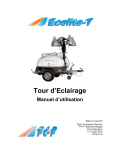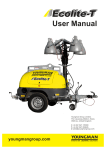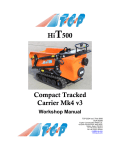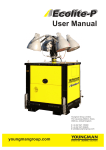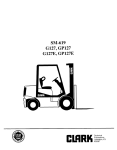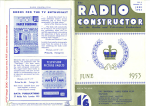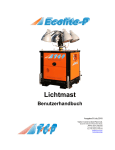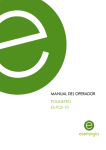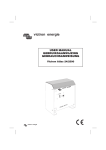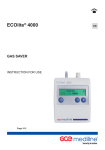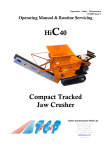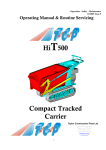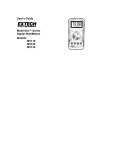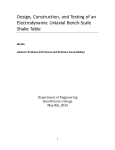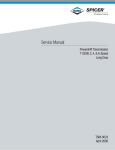Download Lighting Tower Workshop Manual
Transcript
Lighting Tower Workshop Manual TCP-3247-01 Iss.B Nov 09 Taylor Construction Plant Ltd. Quayside Industrial Park, Bates Road, Maldon, Essex, CM9 5FA Tel:+44 (0)1621 850777 Fax:+44 (0)1621 843330 [email protected] www.tcp.eu.com Contents 2 Ecolite Workshop Manual, TCP-3247-01 Iss.B Contents Contents Preliminary 5 Foreword ......................................................... 5 Warranty .......................................................... 5 Liability......................................................... 5 Audits and Surveys ...................................... 5 Service and Warranty Training ..................... 5 Warranty Terms ........................................... 5 General Exclusions: ..................................... 5 Warranty Claim Submission Procedures....... 5 Certificate of Conformity................................... 6 Hatz Engine Dealers ........................................ 6 Service Bulletins .............................................. 6 Machine Identification....................................... 6 Theft Deterrence .............................................. 6 Recovery of a Stolen Machine ...................... 6 Safety .............................................................. 7 General ........................................................ 7 Fire Precautions ........................................... 7 Flammable Fluid Precautions ....................... 7 Electrical Hazard. ......................................... 8 Pre-Starting.................................................. 8 Starting ........................................................ 8 Lubrication and Servicing ............................. 8 Towing Safety .............................................. 9 Specifications................................................... 9 Section 1 Description 11 1.1 Introduction ............................................. 11 1.2 Electrics .................................................. 11 1.2.1 Ignition ............................................. 11 1.2.2 Charging Circuit................................ 12 1.2.3 Oil Pressure Light ............................. 12 1.2.4 Hours Counter .................................. 12 1.3 Lighting Supply........................................ 12 1.4 Road Running Lights............................... 12 1.5 Hydraulics ............................................... 13 Section 2 Operation 15 2.1 Daily Pre-start Inspection......................... 15 2.2 Positioning .............................................. 15 2.3 Uncoupling .............................................. 16 2.4 Jacking up the Unit.................................. 17 2.5 Using the Lights ...................................... 18 2.6 Auxiliary Supply (Optional) ...................... 19 2.7 Moving the Trailer.................................... 19 2.8 Redirecting the Lights.............................. 20 2.9 Parking.................................................... 20 2.10 Emergency Stop.................................... 20 2.11 Starting the Engine with Jumper Cables. 21 2.12 Battery Charging ................................... 21 Section 3 Maintenance 3.1 3.2 3.3 3.4 3.5 3.6 3.7 23 General ................................................... 23 Engine Maintenance................................ 23 Safety Precautions .................................. 23 Maintenance Intervals ............................. 23 Service Access........................................ 23 Lubrication .............................................. 24 General Inspection .................................. 24 Ecolite Workshop Manual TCP-3247-01 Iss.B 3.8 Daily Check............................................. 24 3.9 Engine Oil Check .................................... 24 3.10 Engine Oil Filter..................................... 25 3.11 Engine Oil Change ................................ 26 3.12 Hydraulic Fluid ...................................... 27 3.13 Fuel Filters ............................................ 27 3.14 Tyres..................................................... 28 3.15 Engine Conditioning .............................. 28 3.16 Inertia Brake.......................................... 28 3.17 Draining Fuel Tank................................ 28 3.18 Charging the Battery ............................. 29 Section 4 Fault Finding 4.1 4.2 4.3 4.4 31 Engine will not Crank............................... 31 Engine Cranks but will not Start............... 31 Battery Charging Check .......................... 31 Mast Will not Stay Up .............................. 32 Section 5 Parts Replacement 33 5.1 Recommended Tools .............................. 33 5.2 Lamp replacement .................................. 33 5.3 Housing Removal.................................... 34 5.4 Air Filter .................................................. 34 5.5 Exhaust System ...................................... 34 5.6 Fan Replacement.................................... 35 5.7 Alternator Replacement........................... 35 5.8 Engine Removal...................................... 36 5.9 Hydraulic Pump....................................... 37 5.10 AMOSS Valve Replacement.................. 37 5.11 Mast O-ring Replacement...................... 38 5.12 Mast Seal Replacement ........................ 39 5.13 Mast Flat Bar Replacement ................... 40 Section 6 Drawings 41 6.1 Rolling Chassis Assy TCP-2995 Sh A...... 41 6.2 Rolling Chassis Assy TCP-2995 Sh B...... 42 6.3 Upper Body Assy TCP-2870 Sh 1A ......... 43 6.4 Upper Body Assy TCP-2870 Sh 1B ......... 44 6.5 Upper Body Assy TCP-2870 Sh 2 ........... 45 6.6 Four-head Lamp Gimbal Assy TCP-2970 SA Sh A .............................................................. 46 6.7 Four-head Lamp Gimbal Assy TCP-2970 SA Sh B .............................................................. 47 6.8 Jack Leg Assy TCP1655 ......................... 48 6.9 Jack Leg TCP-2064................................. 49 6.10 SA Fuel Tank Assy TCP-2867 ............... 50 6.11 Hydraulic Schematic.............................. 51 6.12 Hydraulic Assy Layout TCP-3010 .......... 52 6.13 Hydraulic Tank TCP-2862 ..................... 53 6.14 Basic Unit Circuit Diagram 3110-01 ....... 54 6.15 Circuit Diagram – with 230V Output....... 55 6.16 Circuit Diagram – 230V In and Out ........ 56 6.17 Circuit Diagram – 110V CTE Out........... 57 6.17 Cable Identification and Termination Sh 158 6.17 Cable Identification and Termination Sh 259 6.18 Control Box Assy Tank Mounted TCP3001-01 SA.................................................... 60 6.19 Battery Kit TCP-3034 SA....................... 61 6.20 Interior Light Assy TCP-3059 SA ........... 62 6.21 Mud Flap Kit TCP-3104 ......................... 63 3 Contents Appendix A Nut & Bolt Torque Specification 65 1. Specific Torque Settings............................ 65 2. Generic Torque Settings............................ 65 Appendix B Options 4 Ecolite Workshop Manual, TCP-3247-01 Iss.B Preliminary Preliminary Foreword Thank you very much for purchasing this product. We believe that it will serve you without fail. Ensure that you read the operating instructions carefully before use. With proper handling and maintenance, this product will provide reliable, long-term service. This manual is intended to serve as a manual for workshop engineers. It assumes an engineering knowledge commensurate with tasks that will be undertaken in a workshop. For completeness, the manual incorporates operating instructions necessary to familiarise the operator and service engineer with the controls, recommended inspections, start-up, operating, and shutdown procedures for the equipment. All information, illustrations and specifications contained in this publication are based on the latest product information available at the time of publication. The right is reserved to make changes at any time without notice. Continuing improvement and advancement of the design may cause changes to your machine that may not be included in this publication. Please read the operating instructions carefully and understand them before operating the equipment. Warranty Liability The warranty period begins when the product is delivered to and installed at the first purchaser. Only genuine parts may be used to carry out repairs. Failure to use only genuine parts may invalidate the manufacturers warranty. TCP Ltd will not be held responsible if: • the machine has been used to perform tasks that demand more than it’s design and strength limitations, or • the machine has undergone modifications not approved by TCP Ltd, or The warranty liability of TCP Ltd is limited to diagnosis, repair or replacement of the defective part, and actuating the repair - depending on the product terms and conditions, this will be free of charge. TCP Ltd shall be under no liability whatever to the customer for any indirect loss and/or expense (including loss of profit) suffered by the customer arising out of a breach by TCP Ltd of this contract. Audits and Surveys TCP Ltd reserves the right to carry out audits and inspections from time to time in relation to any reimbursed or outstanding warranty claims in order to determine that all relevant details and information is correct. Service and Warranty Training Service and warranty training for service fitters can be provided at competitive rates if required. Training can be carried out at a TCP depot or at a venue of your choice, please contact TCP with your requirements. Warranty Terms One year or 1000 hours whichever occurs first from date of installation All engine warranty issues must be directed to the engine manufacturer, or the manufacturer’s approved/appointed engine dealer. General Exclusions: THE FOLLOWING ARE WARRANTY EXCLUSIONS AS DETERMINED BY HATZ: Service items including lubricants, filters, glow plugs, fuel injection equipment, stop solenoid/relay, charge regulator, leaks (oil and air). IN ADDITION: paintwork and parts that wear. Warranty Claim Submission Procedures • conditions of use have been abnormal, or Claims must be reported accurately and all relevant details given, as follows: • normal maintenance, with regard to requirements as set out and detailed by the manufacturer, have not been adhered to. OWNERS NAME AND ADDRESS: full name and address of customer and site location, if different TCP Ltd will not pay for normal maintenance or servicing nor any materials used to carry out routine servicing. Date of Failure: Ecolite Workshop Manual, TCP-3247-01 Iss.B MACHINE TYPE: State machine type, i.e. Ecolite SERIAL NUMBER: Serial number of unit 5 Preliminary ENGINE NUMBER: Serial number of engine HOURS USED: Sate hours used on hour clock. Please do not guess the hours used quote the machine model and serial number in correspondence with your dealer or the factory. DETAILS OF F AILURE: Give a full report on the failure ORDER NUMBER: An order number will be required Note that the order number is to cover the diagnostic and call out time, as well as to determine the following: • That the failure is to be covered under the terms and conditions of warranty. If this is the case, then the costs will be covered by TCP Ltd and the order number will not be used. • If the failure is determined to be of a nonwarrantable nature, further authorisation to continue will be sought before any rectification work takes place. The information above must be provided even if your warranty claim is a “parts only” claim. An invoice will be raised for the exchange parts. The reported faulty/defective part must immediately be returned to TCP Ltd and full inspection of the parts carried out, if the failure is covered under the terms and conditions of warranty a credit note corresponding to the invoice will be despatched to the customer. If the failure is deemed to be of a non-warrantable nature, the invoice should be settled immediately. Certificate of Conformity Each machine is issued with a certificate of conformity that is sent to the head office of the purchaser. Further copies are available on request Hatz Engine Dealers Fig 1 Data plate Theft Deterrence The owner/operator should take the following precautions to discourage theft, to aid in recovery in the event that the machine is stolen, or to reduce vandalism. • Remove all keys any time the machine is left unattended. • Immobilise the machine by removing a critical electrical or starting system device. • Upon receipt of a machine, record the machine serial number and the serial numbers of allmajor components and attachments. Keep this list up to date and filed in a safe location for fast retrieval. • Place a decal or notice on the machine stating that all serial numbers are recorded. • Discourage the thief! Inspect the gates and fences of the machinery storage yard or construction site. Keep machines in well-lit areas and ask the local law enforcement authorities to make frequent checks around the storage yard or work site. To locate your nearest Hatz dealer, access the HATZ Worldwide page from the http://www.hatzdiesel.de web site. • Liaise with neighbours. Ask them to watch equipment left at job sites and to report any suspicious activities to local allow enforcement authorities. Service Bulletins • Make frequent inventories of machines to promptly detect losses or vandalism. TCP Ltd may from time to time issue service bulletins to keep you up to date as to any improvements or changes that may take place on the complete assembly or component parts. Recovery of a Stolen Machine Machine Identification This manual may refer to controls and equipment that are not present on your particular machine. It is important that you know your machine and its equipment and how to operate it properly. Information regarding the machine model, code and chassis serial number is on the unit serial number plate (Fig 1). This plate is on the front. Always 6 In the event of theft, immediately notify the law enforcement authorities having jurisdiction. Provide the investigating officer with name, type of equipment, chassis and serial numbers of major attachments and components. It would be helpful to show the investigating officer an Operator’s Handbook, photographs, and advertising, to familiarise him with the appearance of the machine. Report the theft to the insurance company. Provide the model and all serial numbers. Ecolite Workshop Manual, TCP-3247-01 Iss.B Preliminary Report the model and serial numbers of the stolen machine to a dealer handling the respective line of equipment. Request that the dealer forward this same information to the equipment manufacturer. Safety Report all malfunctions to those responsible for maintenance. Do not operate the equipment until corrected. Normal service or maintenance performed as required can prevent unexpected and unnecessary down time. This handbook describes general inspections, servicing and operation with the normal safety precautions required for normal servicing and operating conditions. It is not a guide however, for other than normal conditions or situations. Operators and service engineers must be safety conscious and alert to recognise potential operating or servicing safety hazards at all times, and take, necessary precautions to ensure safe operation and servicing of the machine. General • Read this operator’s Handbook and learn the operating characteristics and limitations of the machine. Know what operating clearances the machine requires. • Know clearances of all side and overhead obstructions such as wires, etc., for operating safety. • Be aware of operating hazards that weather changes can create on the job. Know proper procedures to follow when a severe rain or electrical storm strikes. • Know what safety equipment is required and use it. Such equipment may be hardhat, safety glasses, reflector type vests, respirators and earplugs. • Handle fuels and lubricants carefully and clean up spills to avoid fire and slipping hazards. • Never rush. Walk do not run. • Ensure that the area immediately surrounding the light tower is clean, neat and free of debris. • Position and operate light tower on a firm level surface. I • NEVER start a unit that is in need of repair. • Lower tower when not in use, or if high winds or electrical storms are expected in the area. Ecolite Workshop Manual, TCP-3247-01 Iss.B • The tower extends up to 9 m (30 ft.). Make sure area above the tower is open and clear of overhead wires and obstructions. • Bulbs become extremely hot is use! Allow bulb and fixture to cool 10-15 minutes before handling. • Keep area around tower clear of people while raising and lowering mast! • Tower must be levelled and outriggers extended before raising tower. Outriggers must remain extended while tower is up. • DO NOT use a lamp without the glass lens of the lamp unit in place and undamaged. Ceramic discharge metal halide lamps are constructed of an outer glass bulb with an internal arc tube made of ceramic. The arc-tubes operate at high pressure (up to 50 p.s.i.) and at very high temperatures. They can rupture unexpectedly due to ballast failure or misapplication. If an arctube ruptures, it can shatter the outer glass bulb resulting in the discharge of glass fragments and extremely hot ceramic particles (as high as 18320F, 1000C). In the event of such rupture, there is risk of personal injury, property damage, burns and fire if the protective lens is not fitted. Fire Precautions • Clean all dirt, oil, grease and other fluids from systems and components to minimise fire hazards and aid in spotting loose or leaking lines, fittings etc. • Check the engine for rubbish, oily rags or other debris that could cause fires before starting the engine. • Safely dispose of greasy, oily rags or similar hazards. Flammable Fluid Precautions • Take due care when working with fuel. Diesel fuel is a health hazard for contact with eyes or sin, inhalation and ingestion. There is also danger of fire and pollution. • Don’t use diesel fuel or other flammable fluids for cleaning purposes. Use approved nonflammable solvents. • Make sure all-fluid systems caps, drain, valves, fittings, lines etc., are secure and leak free. • Shut off engine and use extra caution if engine is hot when refuelling. 7 Preliminary Never smoke while checking or adding fuel or other fluid or handling fluid containers and lines. • Use care and do not stand downwind when adding fuel or other flammable fluids to tanks and reservoirs to avoid fluids being blown or splashed onto clothing. Starting • Do not start the engine or operate any control if there is a ‘DO NOT OPERATE’ or similar warning sign attached to any control. • When preparing machines or components for storage, seal and tape all openings and close containers tightly to seal in all volatile inhibitor fluids and compounds used. • Use jumper cables only as recommended. Improper use can result in battery explosion or unexpected machine motion. • DO NOT fill fuel tank near an open flame, while smoking, or while engine is running. Lubrication and Servicing • DO NOT fill tank in an enclosed area with poor ventilation. • DO NOT run engine with the fuel tank cap loose or missing. • Do not allow unauthorised personnel to service or maintain the machine. Study the Operator’s handbook and Service Manual before starting, operating or servicing the machine. Electrical Hazard. • Always relieve pressure before servicing any pressurised system. • Never smoke or allow open flames or sparks near batteries. • Use only the special hydraulic fluid supplied by TCP. Unapproved or diluted fluid could freeze in cold conditions resulting in damage to the equipment and/or danger to personnel. • Always disconnect batteries before repairing electrical system to avoid danger of fire-causing sparks. Disconnect battery ground cable first and reconnect last. • Always disconnect batteries and alternator leads before carrying out any welding on the machine. • Never check battery charge by placing metal objects across battery posts to avoid sparks at battery posts. • Use jumper cables only as recommended. Improper use can result in battery explosion. • DO NOT touch or lean against hot exhaust pipes or engine cylinder. • HIGH VOLTAGE! This unit uses high voltage circuits capable of causing serious injury or death. Only a qualified electrician should troubleshoot or repair electrical problems occurring in this equipment. • Replace all guards and safety devices immediately after servicing. • NEVER use tower if insulation on electrical cord is cut or worn through. • Before servicing light tower, make sure engine start switch is turned to OFF, circuit breakers are open (off) and the battery isolation key is removed. NEVER perform even routine service (oi/lfilter changes, cleaning, etc.) unless all electrical components are shut down. • NEVER operate lights without protective lens cover in place or with a lens cover that is cracked or damaged! • Never allow water to accumulate around the base of the light tower set. If water is present, DO NOT service! • Make certain light tower is well grounded and securely fastened to a good earth ground. Pre-Starting • If engine is to be started and run indoors, ensure proper ventilation to remove deadly exhaust gases. • Always perform ‘Pre-Starting Inspection’ instructions described in this manual to ensure the machine is ready for operation. 8 • Never service electrical components if clothing or skin is wet. If the unit is stored outside, check the engine and generator for any moisture and dry the unit before use. • Never wash the unit with a power washer or high pressure hose. • Open main circuit breaker before disconnecting battery cables. • Keep hands, feet, and loose clothing away from moving parts on generator and engine. Ecolite Workshop Manual, TCP-3247-01 Iss.B Preliminary • Replace all missing and hard-to-read labels. Labels provide important operating instructions and warn of dangers and hazards. Specifications Overall length 2503 mm • Make sure slings, chains, hooks, ramps, jacks, and other types of lifting devices are attached securely and have enough weight-bearing capacity to lift or hold the equipment safely. Always remain aware of the position of other people around you when lifting the equipment Overall height, floodlighting position 9500 mm Overall mast height 8740 mm Overall height, travel position 2200 mm Overall width, travel position 1455 mm Overall width with jack legs deployed 2106 mm Tow hitch height 420 mm Wheel size 155/ R13 Axle weight (GVM) 1000 kg Towing Safety Towing a trailer requires care! Both the trailer and vehicle must be in good condition and securely fastened to each other to reduce the possibility of an accident. • Check that the hitch and coupling on the towing vehicle are rated equal to, or greater than, the trailer's "gross vehicle weight rating" (GVWR). • Inspect the hitch and coupling for wear or damage. DO NOT tow trailer using defective parts! • Make sure the coupling is securely fastened to the vehicle. • Check tyres on trailer for tread wear, inflation, and condition. Total weight, with fuel 750 kg Stabilizing/levelling positions 4 Lamps 4 or 6 Operating voltage 110 cte /220V Fuel consumption 0.5 l/hour Fuel tank capacity 95 lts Fuel specification: Diesel meeting EN 590, BS 2869 A1 / A2 or ASTM D 975 - 1D / 2D Total run time 170 hours • Connect breakaway safety line securely to towing vehicle. Braking System Fully fitted axle braking • Make sure directional, reverse and trailer lights are connected and working properly. Ground clearance 240 mm Max wind speed for safe operation Up to 100 kph • Check that wheel nuts are tight and that none are missing. • Maximum recommended speed for highway towing is 75 kph. Recommended maximum offroad towing speed is 15 kph (less on uneven terrain). Additional Safety Systems: Automatic Mast Operating Safety System (AMOSS) fitted as standard • Check that the road running lights are connected and operating, if applicable. Ecolite Workshop Manual, TCP-3247-01 Iss.B 9 Preliminary 10 Ecolite Workshop Manual, TCP-3247-01 Iss.B Section 1 Description 1.1 Introduction Section 1 Description 1.1 Introduction have a Supply Selector switch. The Ecolite is a lighting tower designed for general use on building sites. It features: 1.2.1 Ignition • Four or six adjustable, ceramic discharge metal halide lamps mounted on a telescopic tower. • 9m tower raised and lowered using hydraulics powered by a Hatz diesel engine. • Lights powered from the diesel engine or (optionally) from a local mains supply. • Mounted on a two-wheel trailer that can either be lifted onto a vehicle for transport or towed. • AMOSS system prevents towing while the mast is raised. The mast cannot be raised unless the handbrake is on. Engine starting is controlled by the ignition controller (Fig 1-2). The Hatz diesel engine has no glow plug but employs fuel-rich starting. When the controller key switch is set to 2 (Start), the controller applies 12V d.c. to the starter motor to turn the engine and to a solenoid to supply fuel to the engine. Initially the engine valves are open so that no fuel compression occurs and the engine turns easily. The valves remain open until the engine reaches a pre-determined speed. At this point, the valves close and the resultant compression ignites the fuel and the engine starts. The diesel engine is coupled directly to an alternator to provide 240V a.c. power for the lights. The hydraulic power for raising the tower is provided by a 12V d.c. pump. 1.2 Electrics The diagrams in this section are for explanatory purposes only. Refer to circuit diagrams TCP-32200x in Section 6 for full information. Versions are available with an auxiliary 230V input and/or output. Another version incorporates a transformer to provide a 110V (50 Hz) centretapped output. Only units with a 230V input option Fig 1-2 Ignition Controller Fig 1-1 Ignition circuit Ecolite Workshop Manual, TCP-3247-01 Iss.B 11 Section 1 Description 1.3 Lighting Supply elapsed time while the alternator is operating. 1.2.2 Charging Circuit 1.3 Lighting Supply The engine drives an alternator to provide nominal 230V a.c. for the lights (Fig 1-4). Optionally, the lighting supply can be obtained from an external source connected via a socket on the case and selected by the Supply Selector switch. Also optionally, the generator supply can be fed to a socket on the case. This supply can be 110V if the optional transformer is fitted. 1.4 Road Running Lights Some models have road running lights. Fig 1-3 Charging circuit The alternator unit incorporates a rectifier that converts the a.c. from the alternator into d.c. The regulator regulates the charging current it supplies to the battery to maintain a full charge. 1.2.3 Oil Pressure Light An oil pressure switch turns on the oil pressure warning light if the oil pressure is low. 1.2.4 Hours Counter The hours counter (Fig 1-4), powered from the 230V a.c. supply from the alternator, measures the Fig 1-4 Lights circuit 12 Ecolite Workshop Manual, TCP-3247-01 Iss.B Section 1 Description 1.5 Hydraulics Fig 1-5 Hydraulics 1.5 Hydraulics Refer to the Hydraulic Schematic drawing Fig 1-5. The mast contains concentric, telescopic hydraulic cylinders and is raised by pumping hydraulic fluid into the cylinders. A one-way valve holds the pressure up when the pump is not operating so that the mast will stay up. A solenoid valve lowers the mast by routing the pressurised fluid back to the tank. The Raise/Lower switch activates the pump motor solenoid to raise the mast or activates the Lowering valve to lower it. The Interlock relay ensures that the mast can only be raised or lowered if the 230V supply from the alternator is present – meaning that the engine is running to keep the battery charged for raising the mast. The function of the AMOSS valve is to prevent the unit being moved while the tower is raised. A rod links the handbrake to the AMOSS valve so that if the brake is off, any pressure in the mast cylinders is relieved and the mast comes down. A spring operates on the valve to allow the mast to rise. When the handbrake is off, the rod operates against the spring to prevent raising of the mast. As long as the hand brake is on, the mast can be raised and lowered normally. Ecolite Workshop Manual, TCP-3247-01 Iss.B 13 Section 1 Description 1.5 Hydraulics 14 Ecolite Workshop Manual, TCP-3247-01 Iss.B Section 2 Operation Section 2 Operation 2.1 Daily Pre-start Inspection 2.2 Positioning These instructions must be carried out to assure continuance of engine warranty. When choosing a location of the Ecolite, bear in mind the following: Full routine maintenance procedures are given in Section 3 Maintenance. • The light tower should not be placed where those working under the light are: 1. Ensure that the machine is ready for operation before the starting it. 2. The machine should be in a level position to permit accurate checking of fluid quantities in the engine and other components. 3. Open the left hand side of the engine enclosure to access to the engine for routine maintenance. Note: 4. Refer to the engine manufacture’s handbook for engine maintenance details. Engine - With engine off, check oil level. The oil should be just over the top thread at filler Add oil if low. (See Table 3-2 for correct oil). 5. Inspect the engine air cleaner for any damage. (If damaged, replace it immediately. Using an engine with a damaged air cleaner will seriously reduce engine life). 6. Check that oil cooler outlet grill (between body and chassis) is clear of obstructions. 7. Inspect for any leaks whether fuel, engine oil or hydraulic oil. 8. Check fuel level. To prevent condensation from contaminating the fuel, fill the fuel tank at end of each shift. o Forced to look into the light regularly or o Forced to work with their backs to the light (shadows will block the light from the work area). • Assess site conditions carefully before positioning and operating the tower. • Do not position the tower in the vicinity of overhead cables or power lines! • Locate the light tower on the same or a higher level than the area being lit (the higher the light, the less shadow length). • The area where the tower is positioned should be relatively level. This will ensure smooth, trouble-free telescoping of the mast. (The mast may not telescope down properly if the unit is not level.) • Put the handbrake on before attempting to raise the mast. The mast cannot be raised unless the handbrake is on. • Do not move the tower with the mast raised! (The mast will telescope down automatically if the brake is released). • Never raise the mast or operate the tower without the jacklegs touching the ground! The Ecolite would normally be towed into the required position and then uncoupled from the towing vehicle. However, the Ecolite has a lifting point for use with a crane and two pockets for use with a forklift (Fig 2-1) that can be used. Fig 2-1 Lifting points Ecolite Workshop Manual, TCP-3247-01 Iss.B 15 Section 2 Operation 2.3 Uncoupling Do not release the Jockey Wheel Assy. Clamp Lever while the Jockey Wheel is taking the weight of the unit. The unit would tip forward and could cause damage or personal injury. Uncouple the Ecolite trailer from the towing vehicle, if necessary, as follows: 9. Apply the parking brake by pulling up the lever (Fig 2-2). The mast cannot be raised unless the brake is on. 10. Disconnect the trailer lighting from the towing vehicle. 11. Detach the breakaway cable from the towing vehicle. 12. Release the jockey wheel assembly clamp and lower the wheel approximately half way to the ground. 13. Retighten the clamp. 14. Wind the jockey wheel down to release the weight from the towing eye. 15. Release and remove the pin from the towing eye on the towing vehicle. 16. Make any final adjustments to the position of the unit and apply the parking brake by pulling the lever upward to the limit of its travel. Fig 2-2 Parking brake Coupling the unit to a towing vehicle is the reverse of this procedure. Before moving off, check the tyres and check that the lights on the trailer work. 16 Ecolite Workshop Manual, TCP-3247-01 Iss.B Section 2 Operation Fig 2-3 Jack components 2.4 Jacking up the Unit Jack up the unit as follows. Start with the jack that is on the highest ground. 1. 2. Pull out the Outrigger Locking Pin (Fig 2-5 ) and pull the Jack Leg away from the body of the unit to its fullest extent (Fig 2-6). Hold the Jack Leg with one hand and pull the Rotation Locking pin to release the leg. Allow the leg to fall to the vertical position. Ensure that the pin locks the leg in the vertical position (Fig 2-4). Fig 2-4 Jack vertical Fig 2-5 Extending the jack Ecolite Workshop Manual, TCP-3247-01 Iss.B 17 Section 2 Operation 3. Wind the foot of the jack down to the ground (Fig 2-7). Fig 2-13 Control panel Fig 2-7 Jacking up Fig 2-14 Ignition panel Repeat the procedure for all four jacks so that the unit is stable and level. Do not use the jacks to raise the tyres off the ground. Note: 2.5 Using the Lights 7. Check that the main switch and miniature circuit breakers (MCBs) are on (up) and the Light switches are off. (The main switch is a residual current device (RCD) that can be tripped by an earth leakage.) 8. Set the Supply Selector Switch (if fitted) to Off. Insert the key in the Key Switch and turn it to position 1. The Battery and Oil Pressure lights adjacent to the switch should light. 1. Check that the brake is on. Note that the mast cannot be raised if the brake is off. Check that the brakes are operating correctly on both wheels by attempting to move the trailer. Fig 2-13 shows a 230V machine with an auxiliary output. The mcb configuration on other versions will be different. 2. Check that the light lenses are clean and undamaged. 9. 3. Drive the earth spike (Fig 2-14) into the ground (earth) (follow any risk assessment). Check that the earth spike cable is securely attached to the unit. 10. Turn the key to position 2. 4. Check that the Emergency Stop button is not pressed. If necessary, rotate the button clockwise to release it. 5. Open the cover to access the Control Panel. 6. Check the fuel level and top up if necessary. (The fuel level can be seen through the translucent fuel tank.) 18 11. As soon as the engine starts, release the Key to position 1. Check that the Battery and Oil Pressure lights go out and the green, Running light remains on. Note: If the engine does not start, return the key switch to position 0 before retrying. 12. Check that the lights on the tower are oriented so as to provide optimum illumination of the site. The lights can be tipped up/down and rotated, as required. It is also possible rotate the tower through 300 degrees. See Section Ecolite Workshop Manual, TCP-3247-01 Iss.B Section 2 Operation 2.8 Redirecting the Lights. 13. Raise the tower by turning the Tower switch clockwise and holding it there. 14. Release the Tower switch when the lights reach either the required height or maximum. You will hear a change in the pitch of the hydraulic motor when the mast is fully extended. Note: It is normal for the mast to appear wet as it is raised: the hydraulic fluid acts as a lubricant for the seals between the telescopic sections. Subsequent leakage from a raised mast could indicate a problem with a seal. Seals and O-rings can be replaced as detailed in Sections 5.11 Mast O-ring Replacement and 5.12 Mast Seal Replacement. 15. Set the Supply Selector switch (if fitted) to Generator. To use the auxiliary supply, follow the instructions given in Section 2.5 Using the Lights but set the Supply Selector switch to Aux Input in Step 15. On completion, turn off the generator, leaving the lights powered from the Auxiliary mains input. Where an output socket is fitted, it provides either 110V centre-tap earth (cte) or 220V output (depending on version/region) from the internal alternator. 2.7 Moving the Trailer The trailer cannot be moved with the tower raised. (Releasing the brake causes the tower to telescope down.) To move the trailer: 1. Turn off the lights and allow time for them to cool. 2. Lower the tower. 3. Ensure that the jockey wheel is down and locked so that the unit will not tip over when the jacks are removed. 4. Raise, retract and stow the four jacks. 5. Ensure mast rotation clamp is secure, to prevent movement in transit. 16. Set the Light switches to On (clockwise). The lamps take a minute or two to warm up. 17. Close the cover to protect the Control Panel. Closing down the unit is the reverse of this procedure. Before lowering the tower, switch off the lights and allow time for them to cool. To stop the engine, turn the Key Switch to 0. 2.6 Auxiliary Supply (Optional) Where an input plug is fitted (Fig 2-15), the lamps can be powered from a local mains supply instead of from the generator. Connect the mains supply to the Aux input plug (Fig 2-15). The unit can be either manhandled or towed to the new location. Before towing: • Check that the hitch and coupling on the towing vehicle are rated equal to, or greater than, the trailer's "gross vehicle weight rating" (GVWR). • Inspect the hitch and coupling for wear or damage. DO NOT tow trailer using defective parts! • Make sure the coupling is securely fastened to the vehicle. • Check tyres on trailer for tread wear, inflation, and condition. • Connect breakaway safety line securely to towing vehicle. • Make sure directional, reverse and trailer lights are connected and working properly. • Check that wheel nuts are tight and that none are missing. • Connect the road running lights, if applicable, and check that they work. Fig 2-15 Auxiliary supply connectors Note: To avoid depleting the battery, the unit is configured so that the mast can only be raised with the engine running. Ecolite Workshop Manual, TCP-3247-01 Iss.B The maximum recommended speed for highway towing is 75 kph. Recommended maximum offroad towing speed is 15 kph (less on uneven terrain). 19 Section 2 Operation 2.8 Redirecting the Lights The tower can be rotated through up to 300 degrees so as to direct the light as required. Slacken the Rotation Lock (Fig 2-14) and turn the Rotation Handle so as to direct the lights as required. Tighten the lock afterwards. In addition to rotation of the mast, each of the lights can be rotated on two axes and tipped back and forth (Fig 2-17). Thus the lights can be directed either downwards or horizontally (e.g. to illuminate a facade (Fig 2-16)). For any adjustments, the mast must be lowered to allow access. Fig 2-16 Façade illumination 2.9 Parking When parking the machine overnight or for an extended period, the following procedure will help maintain it in good condition: 1. To prevent condensation from contaminating the fuel, fill the fuel tank completely before parking the machine overnight or for extended periods. If a security kit is supplied, keep it locked 2. Park on level ground where possible. If it must be parked on a slope, position machine at right angles to the slope and block tracks securely. 3. Remove key to a place of safety Fig 2-17 Light manipulation 2.10 Emergency Stop The Emergency Stop button (Fig 2-18) shuts off the engine in under 20 seconds. Fig 2-14 Rotation lock Fig 2-18 Emergency Stop button 20 Ecolite Workshop Manual, TCP-3247-01 Iss.B Section 2 Operation The engine (and the power it generates) will remain off until the Emergency Stop button is released. To release the button, twist it in the direction of the arrows on the button. There is also an emergency stop inside the cover (Fig 2-20). Pull the knob to cut off the fuel to the engine, which will stop after a short delay. 2.11 Starting the Engine with Jumper Cables. For jump starting, jumper cables can be connect can be connected to stud terminals on the side of the engine compartment Fig (2-20). To access these terminals, open the left hand side of the enclosure. Do not jump start a vehicle by using arc welding equipment. Currents and voltages are dangerously high and cannot be sufficiently reduced to make the method safe. Be sure machines are not touching each other. Use cables that are the same size as those on the machine. 5. Keep grounding point clear of battery so that if a spark occurs, it is away from battery fumes (explosive hydrogen). 6. Locate cause of battery failure. 2.12 Battery Charging If the battery is not being charged properly, refer to Section 4.3 Battery Charging Check. The battery can be charged from the mains as detailed in Section 3.18 Charging the Battery. Charging of Odyssey Batteries Check polarity of discharged battery connections. Do not allow charging voltage to exceed 15 volts. Excessive booster voltage and/or incorrect jumper cable connections will destroy plates inside battery. Keep all sources of ignition away from batteries. Do not lean over batteries. Do not allow the battery to become fully discharged. The battery may no be able to recover from this state, rendering it unserviceable. If jumper cables are used to start an engine, be sure to follow this procedure: 1. Connect one end of the jumper cable, usually coloured red, to the + battery supply stud terminal (Fig 2-20). Note: Voltmeter Reading State of charge 12.84 Volts 100% 12.50 Volts 75% 12.18 Volts 50% 11.88 Volts 25% When Ecolite power is supplied from an outside source via the input socket (engine not used and supply Selector switch set to Auxiliary), the Emergency Stop button is inoperative and will not turn off the power. The RCD provides protection against electric shock. Fig 2-20 Internal Emergency Stop 2. Connect the other end of the same cable to the ‘POSITIVE’ (+) post on the booster or charged battery. 3. Connect one end of the second cable, usually coloured black to the NEGATIVE’ (-) post of the booster battery. 4. Connect one end of the jumper cable to the battery supply stud terminal or to a convenient point on the engine frame. Ecolite Workshop Manual, TCP-3247-01 Iss.B 21 Section 2 Operation 22 Ecolite Workshop Manual, TCP-3247-01 Iss.B Section 3 Maintenance Section 3 Maintenance Service interval Every Every 500 hr 1000 hr Every Operation Daily 250 hr Engine Oil Check Change Air filter Check/replace Fuel Filter – in-line Replace Fuel Filter – fixed Replace Hydraulic fluid Check Engine oil filter Clean Lubricate inertia Grease brake Drain fuel tank Annually Engine conditioning * Check/replace air filter daily if operating in dusty conditions Every 1500 hr Ref. Page 24 34 27 27 27 24 28 Decoke 28 28 Table 3-1 |Maintenance Intervals 3.1 General 3.3 Safety Precautions Lubrication is an essential part of preventive maintenance. It is important that the instructions regarding types of lubricants and the frequency of their application be followed to prolong the useful life of the machine. Periodic lubrications of moving parts reduce mechanical failures. • Do not allow unauthorised personnel to service or maintain this machine. While servicing, thoroughly clean all fittings, caps, plugs etc., to prevent dirt from entering the system. • Study the manual before starting, operating or servicing this machine. Always follow the procedures and safety precautions detailed in this manual. Lubricants must be at operating temperatures before draining. • Do not work under or near any unblocked or unsupported linkage, or any part of machine. Do not operate any system unless oil level is within the operating range as indicated on the dipstick or level plug. • Always shut down machine before cleaning, lubricating or servicing the machine All change and service periods are recommendations based on average operating conditions. Lubricants showing evidence of excessive heat, oxidation or dirt should be changed more frequently to prevent these conditions. Lubricants change and service periods must be established on the basis of individual job conditions. 3.2 Engine Maintenance Since the workshop manual provided by the engine manufacturer contains comprehensive information on servicing the engine, this Routine Maintenance section only provides information on the engine for daily servicing and where it differs from the standard application covered by the engine workshop manual. Refer to the manufacturer’s manual for all other information and instructions relating to the engine. Ecolite Workshop Manual, TCP-3247-01 Iss.B • Always relieve pressure before servicing any pressurised system. • Always attach a ‘DO NOT OPERATE’ or similar warning sign to ignition switch or a control before cleaning or servicing the machine. • The ceramic insulation wrapped around the exhaust pipe and the engine cover ceramic heat barrier are made of toxic material – possible, low risk carcinogenic. Minimise dust release and use appropriate ‘Personal Protection Equipment’ when handling them. 3.4 Maintenance Intervals Table 3-1 lists the maintenance intervals. 3.5 Service Access To access the engine for routine maintenance, open both sides of the engine enclosure. 23 Section 3 Maintenance Item Component Lubricant 1 Engine Crankcase and Filter Engine Oil 2 Hydraulic System Hydraulic fluid 3 Fuel tank Diesel Fuel Oil with max. Sulphur 0.5% 4 Towbar greasing Morris Lubricants K2 EP Specifications API Code 1.85% max. sulphated ash limit CC/CD SAE Grade 10W-30 Ecolite Mast Fluid TCP Part No. 80-0372 A.S.T.M. No.2 Diesel Fuel at sub zero temp. blend No. 2 with No.1 Multipurpose Lithiium grease NLGI No.2 Table 3-2 Recommended lubricants 3.6 Lubrication Grease the tow bar coupling at least once per year – more frequently if the unit is towed frequently. 3.7 General Inspection Note: • Service air cleaners more often when operating under extremely dusty conditions. • Do not wash the air cleaner element out with detergent. Replace with new. • Engine air intake. Check air intake system for wear or damage to piping, loose clamps and leaks. 3.9 Engine Oil Check • Check for loose bolts or fixings. Tighten as per bolt chart in Appendix A. 1. Ensure that the unit is level. 2. Switch off the engine. • Check for oil leaks. Securely tighten any loose joints and replenish any losses: 3. Clean the area around the oil filler cap/dipstick. 4. Remove the dipstick (Fig 3-8) and allow a few moments for the oil level to settle. 5. Check the oil level using the dipstick (Fig 3-1). 6. If necessary, top up the oil (see Fig 3-9). Do not overfill. • Examine the body, particularly the chassis, for cracks or broken welds. Repair where necessary. Check the engine oil after each day’s use. Fig 3-1 Dipstick levels 3.8 Daily Check After every 10 hours of operation, do a walk-around inspection: • Visually check engine for damage, listen for any unusual noises: • Engine Air Cleaner, Inspect and remove any obstructions from the air cleaner inlet with the engine stopped: • Check Engine oil level. See Section 3.9 Engine Oil Check. Fig 3-1 Engine side panel 24 Ecolite Workshop Manual, TCP-3247-01 Iss.B Section 3 Maintenance 3.10 Engine Oil Filter Clean the oil filter after every 1000 operating hours. 1. To gain access to the oil filter it is necessary to remove the side panel from the engine. Fig 31 shows the side panel and some of the fixing screws. The oil filter is located near the bottom of the engine (Fig 3-3). Fig 3-5 Oil filter extraction Fig 3-3 Engine oil filter 2. Use an Allen key to remove the filter (Fig 3-4) and extract it (Fig 3-5). 3. Wash out oil filter with degreaser. Replace filter if damaged. 4. Check joint washers (Fig 3-6). Replace if necessary. 5. Lubricate joint washers before fitting. 6. Insert filter to limit of travel. Ensure that tension springs (Fig 3-7) sit close to filter before tightening screw. Fig 3-6 Oil filter washers Fig 3-7 Oil filter spring 7. Unless doing an oil change, check oil level and top up as necessary. Fig 3-4 Unscrewing oil filter Ecolite Workshop Manual, TCP-3247-01 Iss.B 25 Section 3 Maintenance 3.11 Engine Oil Change Parts: Oil filter TCP Change the oil every 250 operating hours. Take care that no contamination enters the sump 1. Ensure that the unit is level. 2. Run the engine until it is warm. 3. Clean the area around the oil filler cap/dipstick. 4. Remove the filler cap/dipstick (Fig 3-8). 5. Attach a suitable tube to the oil evacuation pump and route it to a suitable container. 6. Use the hand pump to evacuate all the oil from the sump. 7. Disconnect the tube. 8. Refill the sump with oil of the correct grade for the conditions (Fig 3-9) to the correct level, as indicated on the dipstick. 9. Refit the filler cap/dipstick. Fig 3-9 Oil SAE grades Oil should meet at least one of the following specifications: ACEA – B2 / E2 or better API – CD / CE / CF / CF-4 / CG-4 or better. If engine oil of a poorer quality is used, reduce oil change interval to 150 hours of operation. Fig 3-8 Oil filler/dipstick and pump 26 Ecolite Workshop Manual, TCP-3247-01 Iss.B Section 3 Maintenance 3.12 Hydraulic Fluid Check the fluid in the hydraulic tank daily. Remove the cap from the hydraulic tank and check the level. The fluid should just reach the bottom of the filter that is under the cap (Fig 3-10). If necessary, top up with Ecolite Mast Fluid (TCP Part No. 80-0372). : Only use the specified TCP hydraulic fluid (undiluted). This fluid is specially formulated for the purpose. If the wrong fluid is used or the fluid becomes diluted, it could freeze under cold conditions with resultant structural damage to the equipment. This could result in injuries to personnel and/or damage to property. If it is suspected that the fluid has become diluted, drain the tank (as described for the fuel, in Section 3.17 Draining Fuel Tank) and refill with the prescribed TCP fluid. Take care not to mix fuel and hydraulic fluid. 3.13 Fuel Filters Parts: In-line fuel filter TCP 14-0131 Fixed fuel filter TCP 14-0128 Take due care when working with fuel. Diesel fuel is a health hazard for contact with eyes or sin, inhalation and ingestion. There is also danger of fire and pollution. Dirty or contaminated fuel will damage the engine. For this reason, three fuel filters are fitted, as follows: Two fuel filters are fitted: one on top of the fuel tank, in the line to the fuel pump (Fig 3-12) and the other mounted on the side of the engine compartment (Fig 3-13). Replace the in-line filter after 250 hours of operation and the fixed filter after 500 hours. Fig 3-10 Hydraulic fluid level check Fig 3-11 Hydraulics Ecolite Workshop Manual, TCP-3247-01 Iss.B 27 Section 3 Maintenance 3.16 Inertia Brake The inertia brake applies the trailer brakes when the towing vehicle brakes. Apply medium multipurpose grease to the nipples (Fig 3-14). Fig 3-12 In-line fuel filter Fig 3-14 Inertia brake grease nipples The frequency of greasing depends on the extent of towing. If the trailer is towed frequently, with frequent braking, the brake will need more frequent greasing than if the brake is seldom used. Fig 3-13 Fixed fuel filter 3.14 Tyres Check the condition of the tyres. They should meet local wear regulations if used on public roads. Check the tyre pressures They should be 2.5 bar (35 psi). 3.15 Engine Conditioning After every 1500 hours of operation, the engine should be run under a 2.6 kW load for two hours in order to clear it of accumulated carbon deposits. The 2.6 kW can comprise a 2 kW load connected to the Auxiliary Supply output plus 600W for the lights. 28 Inspect the brake every three months. If adequate lubricant is showing, grease annually. 3.17 Draining Fuel Tank When working on the fuel system, do not expose it to a naked flame; do not smoke. Over time, condensation results in a layer of water forming at the bottom of the fuel tank, water being heavier than diesel fuel. Once per year, remove the water as follows: 1. Fit a polyethylene tube (diameter 4 mm, length 700mm approx.) to a commercial syringe (20 ml or larger). 2. Remove the diesel filler cap and run the tube down to the bottom of the tank. 3. Drain off the fuel/water mixture with the syringe. 4. Repeat the procedure until the transparent syringe is found to contain only diesel fuel. Ecolite Workshop Manual, TCP-3247-01 Iss.B Section 3 Maintenance 3.18 Charging the Battery The battery can be charged by means of a standard 12V car battery charger. Connect the charger between positive and negative battery stud terminals or between the positive stud and engine chassis (negative) (Fig 3-15). Fig 3-15 Battery test stud Ecolite Workshop Manual, TCP-3247-01 Iss.B 29 Section 3 Maintenance 30 Ecolite Workshop Manual, TCP-3247-01 Iss.B Section 4 Fault Finding Section 4 Fault Finding 4.1 Engine will not Crank The ignition controller (Fig 1-2) controls engine starting. The Hatz diesel engine has no glow plug but employs fuel-rich starting. At startup, the engine valves initially open so that no fuel compression occurs and the starter motor turns the engine easily. The resultant compression ignites the fuel and the engine starts. If the battery voltage is low, the controller releases a solenoid, which cuts off the fuel supply to the engine so that the engine will not start. Similarly, if the engine is running and the battery voltage falls below the acceptable threshold, the engine will stop. This could occur if the mast were raised repeatedly within too short a time for the battery to recharge. 1. Check that Emergency Stop button is released. 2. Check that Supply Selector switch is set to Generator. 3. Check that Supply Isolator switch (if fitted) is on. 4. Check the battery connections. 5. Check the battery voltage with the ignition switch off. This can be measured between the battery test studs shown in Fig 4-1. Fig 4-1 Battery test stud The battery voltage varies with charge as follows: Voltmeter reading 12.84V 12.50V 12.2V 11.9V State of charge 100% 75% 50% 25% If a charging problem is suspected, check the charging circuit as detailed in Section 4.3 Battery Charging Check. 6. Check starter motor. 4.2 Engine Cranks but will not Start 1. Check fuel amount and quality. 2. Check that the emergency Pull to Stop button on the engine compartment is fully in. 3. Check that the electric fuel pump is running. It should produce audible clicking. 4. Check battery voltage as detailed in Section 4.1 Engine will not Crank. 5. To check for water in the base of the fuel filter, unscrew the tap on the underside of the filter. Use a container to catch any water or fuel that comes out. 6. Check the fuel valve, accessed by removing the side panel of the engine compartment. The valve should produce an audible click when the ignition is turned on. Check the continuity of the valve solenoid. Fig 4-2 Fuel valve 4.3 Battery Charging Check The battery is charged from an a.c. alternator driven by the engine. A regulator converts the a.c. to a d.c. charging current, which it regulates to ensure a full battery charge. To check charging, start the engine and measure the battery voltage. The charging voltage should be of the order of 14V. If the battery voltage has not Ecolite Workshop Manual, TCP-3247-01 Iss.B 31 Section 4 Fault Finding increased significantly from its off-load value, suspect an alternator, regulator or wiring problem. To check the alternator, switch off the engine, disconnect the connections to the alternator and connect an d.c. voltmeter to the alternator. Start the engine and measure the (off-load) output from the alternator, this should be more than 14V d.c. If the alternator output is correct, check the regulator and wiring as detailed in the engine workshop manual. 32 4.4 Mast Will not Stay Up Check that the handbrake is fully on. Check that the linkage to the handbrake is correctly operating the AMOSS valve under the tow bar. Check for leakage around the mast segments. If necessary, replace the relevant seals on the mast (See Section 5.12 Mast Seal Replacement ). Ecolite Workshop Manual, TCP-3247-01 Iss.B Section 5 Parts Replacement Section 5 Parts Replacement 5.1 Recommended Tools • Crows foot 32 mm spanner 5.2 Lamp replacement Note: 1. Do not touch the lamp bulb with bare fingers. The grease deposited from skin will cause the lamp to fail when it is turned on. Ensure that the new lamp is clean. Release the clips securing the lens (Fig 5-1) and remove the lens (Fig 5-2). Fig 5-2 Lamp lens 2. Unclip the lamp from the holder (Fig 3-3). 3. Install the new lamp and refit the lens. Fig 5-1 Lens clips Fig 3-3 Lamp and holder Ecolite Workshop Manual, TCP-3247-01 Iss.B 33 Section 5 Parts Replacement 5.3 Housing Removal The housing is held in place by the lifting frame. 1. Release the lifting frame by removing the two bolts at the rear (Fig 5-4) and the single bolt at the front (Fig 5-3) 2. If necessary, disconnect the licence plate wiring. 3. Remove the lifting frame and lift off the housing. Fig 5-6 Air filter element Refitting is the reverse of this procedure. Fig 5-3 Lifting frame front fixing Fig 5-7 Safety element Check the air filter every 250 operating hours daily under dusty conditions. The filter comprises an outer filter element and an inner safety element, intended to stop the filter element being sucked in. Fig 5-4 Lifting frame rear fixing 5.4 Air Filter Parts: Air filter element Safety element TCP 10-0273 TCP 10-0274 1. Open the cover to access the air filter assembly. 2. Unscrew the air filter cover (Fig 5-5). 3. Extract the filter element (Fig 5-6). 4. Extract the inner, safety element (Fig 5-7). 5. Replace filter if damaged or dirty. 6. Reassemble the filter assembly. 5.5 Exhaust System The ceramic wrapping on the exhaust pipe is toxic – possible, low risk carcinogenic. Minimise dust release and use appropriate personal protection equipment when handling it. Fig 5-5 Air filter cover removal 34 Parts: 10-2924 10-3003 10-2962 10-2878 10-3032 Silencer Exhaust Flexible Pipe Exhaust Elbow Exhaust Outlet Pipe Silencer + Spark Arrestor MS Ecolite Workshop Manual, TCP-3247-01 Iss.B Section 5 Parts Replacement 1. Release the clamp securing the exhaust chamber to the down pipe on the underside of the unit. 5.7 Alternator Replacement 1. Ensure that the engine is switched off. Remove and pocket the key. 2. Isolate the battery by disconnecting the negative terminal of the battery. 3. Remove the enclosure as detailed in Section 5.3 Housing Removal. 4. Remove the side, top and fan panels from the engine compartment. 5. Unbolt Hatz engine controller from control panel and lift away with engine pod. 6. Disconnect cables from alternator (white multi-connector). Fitting the exhaust is the reverse of this procedure. 7. Remove the two or four screws securing the alternator vibration mount(s) to the base. 5.6 Fan Replacement 8. Remove the four screws securing the alternator to the engine. 2. Remove the four screws securing the exhaust chamber (Fig 5-8) and remove the chamber. Fig 5-8 Exhaust chamber fixing points To replace the fan on the engine compartment: 1. Ensure that the engine is switched off. Remove and pocket the key. 2. Isolate the battery by disconnecting the negative terminal of the battery. 3. Remove the enclosure as detailed in Section 5.3 Housing Removal. 4. Remove the side panels from the engine compartment. 5. Remove the concertina hose from the fan. 6. Remove the panel on which the fan is mounted. Fig 5-10 Fan 9. Remove the alternator end cap (two screws). 10. Unscrew the tie bolt that passes through the centre of the alternator. The next step is to disconnect the alternator from the motor, which drives the alternator via a tapered shaft (Fig 5-11). Fig 5-9 Fan 7. Disconnect the fan supply leads. The red lead unplugs from a free socket. The black lead is attached to the alternator frame. 8. Remove the fan from the panel (four screws). Fitting the new fan is the reverse of this procedure. Fig 5-11 Drive shaft on alternator Ecolite Workshop Manual, TCP-3247-01 Iss.B 35 Section 5 Parts Replacement 11. Screw the tie bolt two turns back into the shaft. While pulling the alternator away from the engine, tap sharply on the end of tie bolt with a copper mallet to release the shaft from the taper. If necessary, use a pry bar in the gap between the alternator and the engine to prise them apart while tapping the bolt. Fitting the new alternator is the reverse of this procedure. 5.8 Engine Removal Fig 5-13 Engine exhaust outlet 7. Disconnect the fuel lines. Take due care when working with fuel. Diesel fuel is a health hazard for contact with eyes or sin, inhalation and ingestion. There is also danger of fire and pollution. The engine is heavy. Use appropriate lifting equipment and/or get the necessary help. 1. Ensure that the engine is switched off. Remove and pocket the key. 2. Isolate the battery by disconnecting the negative terminal of the battery. 3. Remove the enclosure as detailed in Section 5.3 Housing Removal. 4. Remove the four bolts securing the engine pod to the Ecolite chassis. 5. Disconnect the lead to the alternator from the terminal block attached to the underside of the plate on the top corner of the engine pod (Fig 5-12) and extract the lead from the engine pod. Fig 5-14 Fuel lines 8. Disconnect the concertina duct from the engine extractor fan. Fig 5-15 Engine extractor duct 9. Attach the hoist straps to the lifting eyes of the engine pod. 10. Lift the pod out and deposit it on a bench working area. 11. Remove the two screws securing the dip stick and pump assembly to the panel. Fig 5-12 Alternator connector block 6. Disconnect the exhaust at the elbow where the pipe leaves the engine pod. Fig 5-16 Dipstick securing screws 36 Ecolite Workshop Manual, TCP-3247-01 Iss.B Section 5 Parts Replacement 12. Tip the engine pod on its side to reveal the sump cover. 13. Disconnect the sump adaptor from the dipstick assembly (Fig 5-18). A B Fig 5-21 Disconnecting pump assembly 6. Fig 5-19 Sump cover and adaptor hose Remove the four screws securing the pump assembly to the tank 14. Remove the sump cover from the frame. 15. Remove the hose from the sump adaptor and unscrew the sump adaptor from the sump. Fig 5-22 Pump screws 7. Fig 5-18 Sump adaptor 16. Remove the four bolts securing the engine to the pod and lift out the engine. 17. Remove the alternator from the engine as described in Section 5.7 Alternator Replacement. Fitting the new engine is the reverse of this procedure. Fit the sump adaptor and hose from the old engine to the sump of the new engine. Carefully lift out the pump, taking care not to to observe the safety precautions appropriate to the hydraulic fluid. Refitting is the reverse of this procedure. 5.10 AMOSS Valve Replacement Recommended tools: Crows foot 32 mm spanner. The AMOSS valve is responsible for ensuring that the mast cannot be raised unless the handbrake is off. It is located under the tow bar. 5.9 Hydraulic Pump 1. Ensure that the engine is switched off. Remove and pocket the key. 2. Isolate the battery by disconnecting the negative terminal of the battery. 3. Remove the enclosure as detailed in Section 5.3 Housing Removal. 4. Disconnect the supplies to the pump motor and the pump motor solenoid.5. Disconnect the hoses from the pump assembly (Fig 5-21). Ecolite Workshop Manual, TCP-3247-01 Iss.B Fig 5-23 AMOSS valve 37 Section 5 Parts Replacement When removing the nuts securing the valve to the cross strut and the hose connector, take care to avoid turning the 41 mm nuts on the valve as they have a very low torque setting. 4. Using a hammer and copper drift, tap off the cap (Fig 5-25 ) and raise it a few cm. The Oring is located just under the rim of the cap (Figs 5-26 and 5-30). 5.11 Mast O-ring Replacement 1. Remove the bolt securing the Light Assembly to the mast and lift the assembly off the mast using a hoist or similar. 2. At the cap containing the faulty O-ring, remove the screws securing the cap. (Fig 524) Fig 5-26 O-ring Fig 5-24 Hoisting mast section 3. Attach a strop to the assembly just above the cap and use a hoist or fork-lift to raise the upper section by about 20 cm. (Fig 5-26) 5. Extract the O-ring from the cap rim. 6. Carefully clean the area. 7. Remove the strop from the assembly 8. Remove the O-ring by stretching it and lifting it over the assembly (Fig 5-27). Fig 5-27 Removing O-ring Fig 5-25 Removing cap 38 Fitting a new O-ring is the reverse of this procedure. However: Ecolite Workshop Manual, TCP-3247-01 Iss.B Section 5 Parts Replacement • Be sure to use the correct O-ring. There is a different size for each mast section – numbered 1 for the bottom one (largest) to 6 for the top one. • Ensure that the O-ring and the surrounding area are clean. • Apply water-resistant grease to the area. • After stretching the new O-ring over the caps, allow time for the ring to regain its proper size before attempting to fit it into the groove in the cap. • On refitting the cap, tap it down with a soft mallet. Fig 5-30 Mast detail 5.12 Mast Seal Replacement Tools: A machine seal guide kit 51-0381. A seal is fitted in each of the caps on the mast. Each seal is a combination pressure and wiper seal. Fig 5-28 Refitting cap • After refitting the cap, check for rubber debris in the cap fixing holes (Fig 5-29). The presence of debris could indicate that the Oring has been damaged by a burr around the hole. If debris is present, remove and check/replace the O-ring. Fig 5-31 Mast seal Fig 5-29 Checking for debris Ecolite Workshop Manual, TCP-3247-01 Iss.B 1. Remove the bolt securing the Light Assembly to the mast and lift the assembly off the mast using a hoist or similar. 2. Mark the caps with Tipex or similar to ensure that they can be refitted with the correct orientation. 3. Remove the caps down to and including the cap with the faulty seal, as described in Section 5.11 Mast O-ring Replacement. 4. Check/replace the suspect seal. Also check/replace the O-ring. 5. Carefully clean the area and apply waterresistant grease. 6. Check/replace the seals and O-rings on the remaining caps that have been removed. 39 Section 5 Parts Replacement 7. Refit the caps as described in Section 5.11 Mast O-ring Replacement. However: • Ensure that the orientation of each cap is correct, as marked (Fig Error! Reference source not found.). • Use the guide jigs as shown in Fig 5-32. These compress the inner pressure seal so that the cap will fit over the tube. 5.13 Mast Flat Bar Replacement Within each cylinder of the mast, two flat bars connect upper and lower sections to maintain their alignment. The bars are not fixed in place but sit in slots at top and bottom. To replace a bar, proceed as follows: 1. Remove the bolt securing the Light Assembly to the mast and lift the assembly off the mast using a hoist or similar. 2. Mark the caps with Tipex or similar to ensure that they can be refitted with the correct orientation. (Fig Error! Reference source not found.) 3. Attach two strops to the cap where the problem lies and hitch them to a hoist. Fit the strops in such a way as to ensure horizontal stability. 4. Hoist the mast section clear of the remainder to reveal the two flat bars. 5. Remove the faulty bar and replace it with a new one. The bar sits in a slot at the bottom of the assembly. The new bar will be seen to be slightly bowed. Orient the bar so that it bows out at the centre. When in place, it will thus be supported by the outer cylinder. 6. Smear some thick grease on the outer surface of the top of the bars and press them against the cylinder. The grease is intended to keep the bars in position until they can be engaged with the top slots. 7. Quickly and carefully, lower the assembly, with the correct orientation, into the cylinder and position it so that the bars fit into the designated slots. If the bars come adrift, repeat the procedure. 8. Reassemble the unit. Fig 5-32 Fitting a cap 40 Ecolite Workshop Manual, TCP-3247-01 Iss.B Section 6 Drawings Section 6 Drawings 6.1 Rolling Chassis Assy TCP-2995 Sh A Ecolite Workshop Manual, TCP-3247-01 Iss.B 41 Section 6 Drawings 6.2 Rolling Chassis Assy TCP-2995 Sh B 42 Ecolite Workshop Manual, TCP-3247-01 Iss.B Section 6 Drawings 6.3 Upper Body Assy TCP-2870 Sh 1A Ecolite Workshop Manual, TCP-3247-01 Iss.B 43 Section 6 Drawings 6.4 Upper Body Assy TCP-2870 Sh 1B 44 Ecolite Workshop Manual, TCP-3247-01 Iss.B Section 6 Drawings 6.5 Upper Body Assy TCP-2870 Sh 2 Ecolite Workshop Manual, TCP-3247-01 Iss.B 45 Section 6 Drawings 6.6 Four-head Lamp Gimbal Assy TCP-2970 SA Sh A 46 Ecolite Workshop Manual, TCP-3247-01 Iss.B Section 6 Drawings 6.7 Four-head Lamp Gimbal Assy TCP-2970 SA Sh B Ecolite Workshop Manual, TCP-3247-01 Iss.B 47 Section 6 Drawings 6.8 Jack Leg Assy TCP1655 48 Ecolite Workshop Manual, TCP-3247-01 Iss.B Section 6 Drawings 6.9 Jack Leg TCP-2064 Ecolite Workshop Manual, TCP-3247-01 Iss.B 49 Section 6 Drawings 6.10 SA Fuel Tank Assy TCP-2867 50 Ecolite Workshop Manual, TCP-3247-01 Iss.B Section 6 Drawings 6.11 Hydraulic Schematic Ecolite Workshop Manual, TCP-3247-01 Iss.B 51 Section 6 Drawings 6.12 Hydraulic Assy Layout TCP-3010 52 Ecolite Workshop Manual, TCP-3247-01 Iss.B Section 6 Drawings 6.13 Hydraulic Tank TCP-2862 Ecolite Workshop Manual, TCP-3247-01 Iss.B 53 Section 6 Drawings 6.14 Basic Unit Circuit Diagram 3110-01 54 Ecolite Workshop Manual, TCP-3247-01 Iss.B Section 6 Drawings 6.15 Circuit Diagram – with 230V Output Ecolite Workshop Manual, TCP-3247-01 Iss.B 55 Section 6 Drawings 6.16 Circuit Diagram – 230V In and Out 56 Ecolite Workshop Manual, TCP-3247-01 Iss.B Section 6 Drawings 6.17 Circuit Diagram – 110V CTE Out Ecolite Workshop Manual, TCP-3247-01 Iss.B 57 Section 6 Drawings 6.18 Cable Identification and Termination Sh 1 58 Ecolite Workshop Manual, TCP-3247-01 Iss.B Section 6 Drawings 6.19 Cable Identification and Termination Sh 2 Ecolite Workshop Manual, TCP-3247-01 Iss.B 59 Section 6 Drawings 6.20 Control Box Assy Tank Mounted TCP-3001-01 SA 60 Ecolite Workshop Manual, TCP-3247-01 Iss.B Section 6 Drawings 6.21 Battery Kit TCP-3034 SA Ecolite Workshop Manual, TCP-3247-01 Iss.B 61 Section 6 Drawings 6.22 Interior Light Assy TCP-3059 SA 62 Ecolite Workshop Manual, TCP-3247-01 Iss.B Section 6 Drawings 6.23 Mud Flap Kit TCP-3104 Ecolite Workshop Manual, TCP-3247-01 Iss.B 63 Section 6 Drawings 64 Ecolite Workshop Manual, TCP-3247-01 Iss.B Appendix A Nut & Bolt Torque Specification Appendix A Nut & Bolt Torque Specification 1. Specific Torque Settings Wheels 80-90 nm Fig A-1 Light fitting torque settings 2. Generic Torque Settings Bolts not defined above should be tightened to the torque settings listed in Table A-1. Friction coefficient total 0.14 for screws and nuts without after treatment as well as for phosphate nuts. Tighten by hand. If nothing special is indicated, select correct torque limits from the following tabulations: Size 6.9 Some Engine Bolts 8.8 Standard Hex Bolt 10.9 Some Engine Bolt 12.9 Standard Cap head Nm (Ibfft) Nm (Ibfft) Nm (Ibfft) Nm (Ibfft) M6 8.5 (6.3) 10 (7.4) 14 (10.3) 17 (12.5) M8 M10 M12 M14 M16 M18 M20 M22 M24 M27 21 41 72 115 180 245 345 465 600 890 (15.5) (30.2) (53.1) (85) (133) (181) (255) (343) (443) (656) 25 49 86 135 210 290 410 550 710 1050 (18.4) (36.1) (63.4) (100) (155) (214) (302) (406) (524) (774) 35 69 120 190 295 400 580 780 1000 1500 (25.8) (50.9) (88.5) (140) (218) (295) (428) (575) (738) (1106) 41 83 145 230 355 485 690 930 1200 1800 (30.2) (61.2) (106.9) (170) (262) (358) (509) (686) (885) (1328) M30 1200 (885) 1450 (1070) 2000 (1475) 2400 (1770) Table A-1 Torque settings for Metric ISO Thread DIN 13 Ecolite Workshop Manual, TCP-3247-01 Iss.B 65 Appendix A Nut & Bolt Torque Specification 66 Ecolite Workshop Manual, TCP-3247-01 Iss.B Appendix B Options Appendix B Options Ecolite Workshop Manual, TCP-3247-01 Iss.B 67




































































